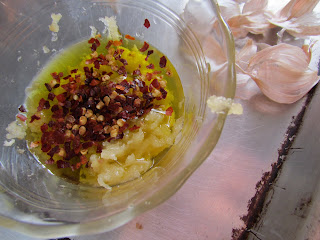Salty and satiny prosciutto goes well with firm but sweet and juicy flavorful fruits.
Fresh figs are great when you can find them, and autumn should be a good time of year for fig hunting at the grocery store or market.
If you've never had a fresh fig, let me try to assure you they're nothing like dried figs or dried-fig filled cookies in taste. Besides, they look much better, too.
If you've never had a fresh fig, let me try to assure you they're nothing like dried figs or dried-fig filled cookies in taste. Besides, they look much better, too.
Ripe figs should have a sweet perfume, a beautiful, deep color, and be plump and slightly soft- not mushy.
Textural and flavor variety are good in a salad. They keep things interesting and each bite is a little different, depending on what you pick up on your fork.
I generally like salads with at least a little bed of greens. It adds color as well as some order to the plate (plus, you're able to pick up more of the vinaigrette).
Heads of Boston lettuce are small, with tender and mild leaves. They sort of blend in well with the rest of the salad ingredients.
If you don't have (or can't find) fresh mozzarella, bits of chèvre or thin Parmesan shards might be nice alternatives.
Fig and Prosciutto Salad
Adapted from Jamie Oliver's Happy Days with the Naked Chef
serves 4-5
3 T fresh lemon juice
1 T balsamic vinegar
Scant 1 T honey
A few sprigs fresh thyme, leaves removed and roughly chopped
6 T olive oil
Kosher salt
Freshly ground black pepper
2 heads Boston lettuce leaves well washed, drained, and torn into bite-sized pieces
8-10 fresh figs (2 per person), quartered
5-7 slices of prosciutto
4-5 oz fresh mozzarella
8-12 fresh basil leaves
In a small bowl, whisk together lemon juice, vinegar, honey, and thyme until the honey is completely dissolved. Slowly whisk in the olive oil until emulsified. Add 1/2 t kosher salt and 1/4 t black pepper to the dressing. Whisk to incorporate, taste by dipping a lettuce leaf into the vinaigrette, and re-season as necessary. Set aside.
Place a bed of lettuce on each plate. Arrange 8 pieces of fig atop each salad. Cut or tear prosciutto into rough pieces and divide among plates. If mozzarella is in a large ball, cut into bite-sized pieces and divide between the salads.
Re-whisk the dressing and drizzle on top of the salads.
Tear the basil (2-3 leaves per salad), and sprinkle on top of everything.
Serve immediately.
Tear the basil (2-3 leaves per salad), and sprinkle on top of everything.
Serve immediately.






























































